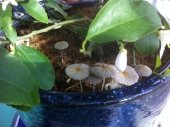Generally, plants thrive or fail due to two simple reasons. 1. Poor soil. 2. Adequate moisture. So before you go too far with selecting and planting trees, I'd put some thought into improving the soil where you'll be planting the trees. Quite simply, get a lot of decomposing biomass and leave it in the spots where you'll be planting your trees. A 3 foot pile of grass, weeds, tree trimmings, leaves, veggie scraps, etc. will serve to condition the soil. Pile it up, keep it slightly moist, and let it decompose. When you're ready to plant, you can just push a spade down through the center of the pile, hollow it out like a donut, and dig your hole down into the center of it. Thus, you'll have a great start with your soil, and all that
carbon biomass will keep the soil moist once you've planted.
A couple of thoughts about tree selection:
1. What size do you want? If you've got the space, select "standard" sized. You will need to then space them appropriately. I plant standard trees at least 15 feet apart. When you are planting bare-root trees, that seems like it's too far apart. But once they start growing, they will quickly fill the space. If you plant semi-dwarf or dwarf trees, then plant them 12 or 10 feet apart, accordingly. Give yourself space to move around them.
2. You mention Home Depot. I'm not a big fan of getting my fruit trees from a Big Box retailer. Here in California, I order my trees from Armstrongs. They will get me exactly the variety of tree that I want. At Home Depot or Lowes, they'll have 3 or 4 varieties, but often not the best ones suited for your climate. You'll have no say about the best rooting stock or size of tree -- just take it or leave it. Perhaps someone who is from your region can make a better suggestion.
3. Choosing the variety of trees that you want to plant depends upon a couple of things. First, the number of chill hours that you get. Don't order a tree that requires 1000 chill hours if you only get 250. Where I live (Los Angeles country), I'll get, at most, 300 chill hours. This past winter, we barely got 150. So I've had to plant only low low chill varieties. I've got 5 different apples, 3 different asian pears, a lot of different stone fruits (apricots, apriums, plums, pluots, etc.), 3 different figs, lots of different citrus . . . and all of them are at about 250 chill hours or lower. So choose wisely.
Here is where I get my best information from: Dave Wilson Nursery.
http://www.davewilson.com/product-information/category/fruit-trees
4. Choose trees that will not all ripen at the same time. What good it is to have 4 peach trees if they all ripen in the same 2-week window in early June, and you can't possibly eat or process them all? So select trees so that you have a progressive ripening of fruit throughout the growing season. We've got fruit ripening throughout the growing season --- really, we've got something to eat off a tree 12 months of the year. Here is a chart that shows when various varieties of fruit ripen.
http://www.davewilson.com/sites/default/files/fruit_nut_chart_hg_2010.pdf
5. Select trees that will cross pollinate for best results. Apples, pears, plums & pluots . . . they do better when there are several other varieties of the same fruit tree nearby. I plant my apple trees in proximity: Anna, Dorsett Golden, Cripps Pink, Fuji and Gala—the
bees don't have to work too hard to move back and forth between them. Some trees are not self-fruitful, so you'll need to find a pollenizer for them. For example, I've got Royal Lee and Minnie Royal cherry trees that need each other in order to pollinate.
6. If you've never heard of Stephan Sobkawiak, Miracle Farm up in Canada, you need to watch his stuff. He's absolutely brilliant.
https://miracle.farm/en/
I wish I had heard of him before I started to plant out my food forest. Never the less, I've gone back and copied so many of the things that he's doing. Brilliant.
Best of luck to you. Take your time and do it right the first time. I know that you are in a hurry and want to get fruit production as soon as possible, but it makes far more sense to me that you take your time and plan everything out right the first time, buy only the best trees, get your design right, get your soil healthy . . . and THEN plant out your orchard. In 5 years you'll have more fruit then you know what to do with.





 1
1




 1
1
























.jpg)
